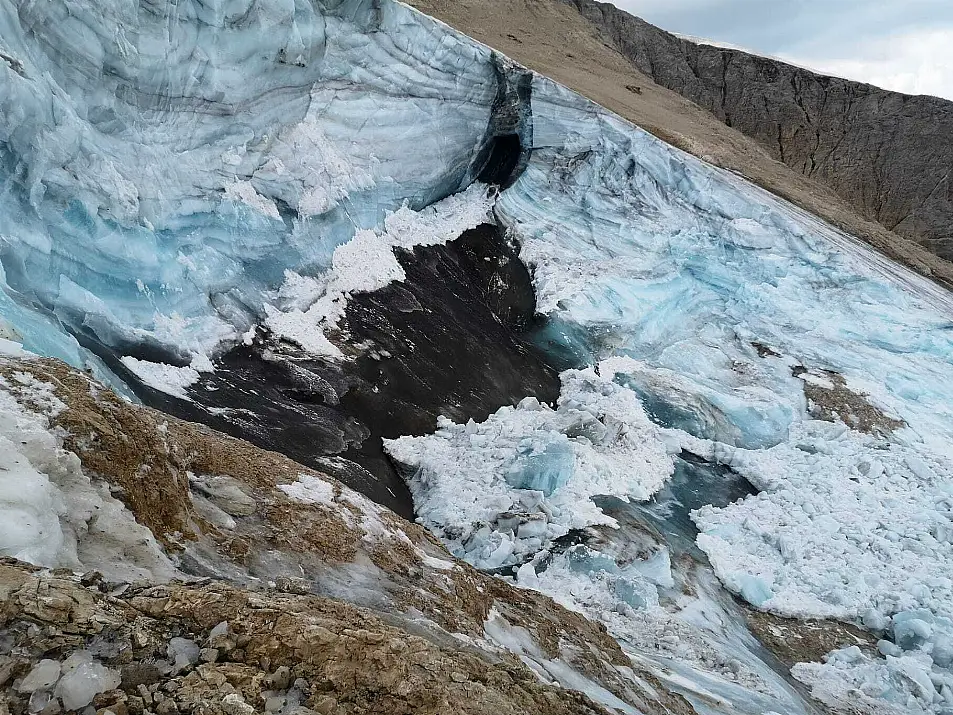Thunderstorms have hampered the search for more than a dozen hikers who remain unaccounted for a day after a huge chunk of an Alpine glacier in Italy broke off, sending an avalanche of ice, snow and rocks down the slope.
Officials put the known death toll at seven.
“I hope the numbers stop here,” said Veneto governor Luca Zaia, whose region in north-east Italy borders the Dolomite mountain range including the Marmolada glacier.
He spoke in the resort town of Canazei, where a morgue was set up in the ice rink.

Another regional leader, Maurizio Fugatti, said that by Monday afternoon 14 people remained unaccounted for: 10 Italians, three from the Czech Republic and one from Austria.
“We were contacted by families because these people didn’t return home,” said Mr Fugatti of the Trentino-Alto Adige Alpine region.
In the mountain’s car park, four vehicles remained whose occupants had not been traced – two cars had plates from the Czech Republic, one from Germany and the fourth from Hungary.
Mr Fugatti raised the possibility that there might be people whose families do not know their status since they might be on holiday and only check in with relatives at the end of the trip.
At least three of the dead were Italians, authorities said. Italian news reports said one of the deceased was from the Czech Republic.
On Sunday, officials said nine people were injured, but officials at a news conference on Monday in the resort town of Canazei said there were eight injured, including two in hospital in what they described as a grave condition.

Mr Zaia said those in hospital included two Germans and a 40-year-old patient yet to be identified.
The avalanche came roaring down when dozens of hikers were on excursions, including some of them roped together.
Italian Premier Mario Draghi, flanking the officials after meeting with family members of some of the dead, expressed “the most sincere, affectionate, heartfelt closeness” to the families.
Looking grim, he demanded that action be taken so such a tragedy does not happen again.
“This is a drama that certainly has some unpredictability,” Mr Draghi said, echoing several experts who said an avalanche triggered by a glacier’s break-up could not be forecast.
But what happened “certainly depends on environmental deterioration and the climate situation”, the premier said.
The Marmolada glacier has been shrinking for decades, and scientists at the government CNR research centre have said it will not exist within 25-30 years.

“Today, Italy gathers close” around the stricken families, Mr Draghi said. “The government must reflect on what happened and take measures, so that what happens has a very low possibility, or none, of repeating itself.”
The detached portion of glacier was massive, estimated at 200 metres wide, 80 metres tall and 60 metres deep. Mr Zaia likened the avalanche to an “apartment building (sized) block of ice with debris and Cyclopean masses of rock”.
”I can’t say anything else other than the facts, and the facts tell us that the high temperatures don’t favour these situations,” Mr Zaia told reporters.
Italy is in the grips of a heatwave, and Alpine rescuers said that the temperature at the glacier’s altitude last week topped 10C (50F) when usually it should hover around freezing at this time of year.

Drones were being used to help look for any of the missing, but even they had to stop operating when thunderstorms lashed the area in late morning.
What caused a pinnacle of the glacier to break off and thunder down the slope at a speed estimated by experts at nearly 200mph was not immediately known.
But the heatwave gripping Italy since May, bringing temperatures unusually high for the start of summer even up in the normally cooler Alps, was being cited as a likely factor.
Jacopo Gabrieli, a polar sciences researcher at Italy’s state-run CNR research centre, noted that the long heatwave, spanning May and June, was the hottest in northern Italy in that period for nearly 20 years.
“It’s absolutely an anomaly,” Mr Gabrieli said in an interview on Italian state TV.
Like other experts, he said it would have been impossible to predict when or if a serac – a pinnacle from a glacier’s overhang – could break off, as it did on Sunday.
Alpine rescuers on Sunday noted that late last week, the temperature on the 3,300-metre high peak had topped 10C (50F), far higher than usual.

Operators of rustic shelters along the mountainside said temperatures at the 2,000-metre level recently reached 24C (75F), unheard-of heat in a place where visitors go in summer to keep cool.
The glacier, in the Marmolada range, is the largest in the Dolomite mountains in north-eastern Italy. People ski on it in the winter.
But the glacier has been rapidly melting away over the past decades, with much of its volume gone.
Experts at Italy’s state-run CNR research centre, which has a polar sciences institute, estimated a couple of years ago that the glacier will not exist within 25-30 years.
The Mediterranean basin, which includes southern European countries such as Italy, has been identified by UN experts as a “climate change hot spot”, likely to suffer heatwaves and water shortages, among other consequences.
Pope Francis, who has made care of the planet a priority of his papacy, tweeted an invitation to pray for the avalanche victims and their families.
“The tragedies that we are experiencing with climate change must push us to urgently search for new ways that are respectful of persons and nature,” Francis wrote.







